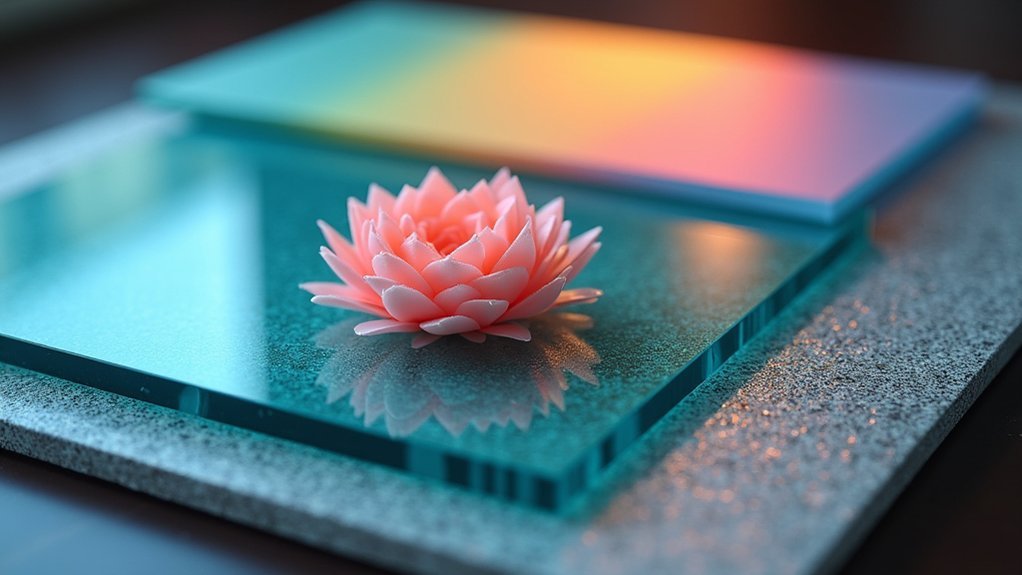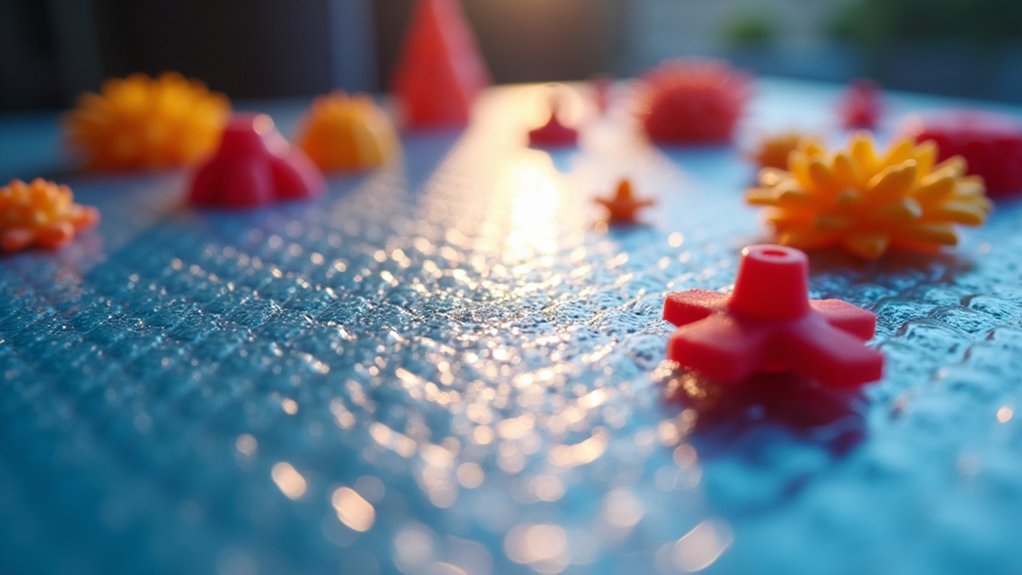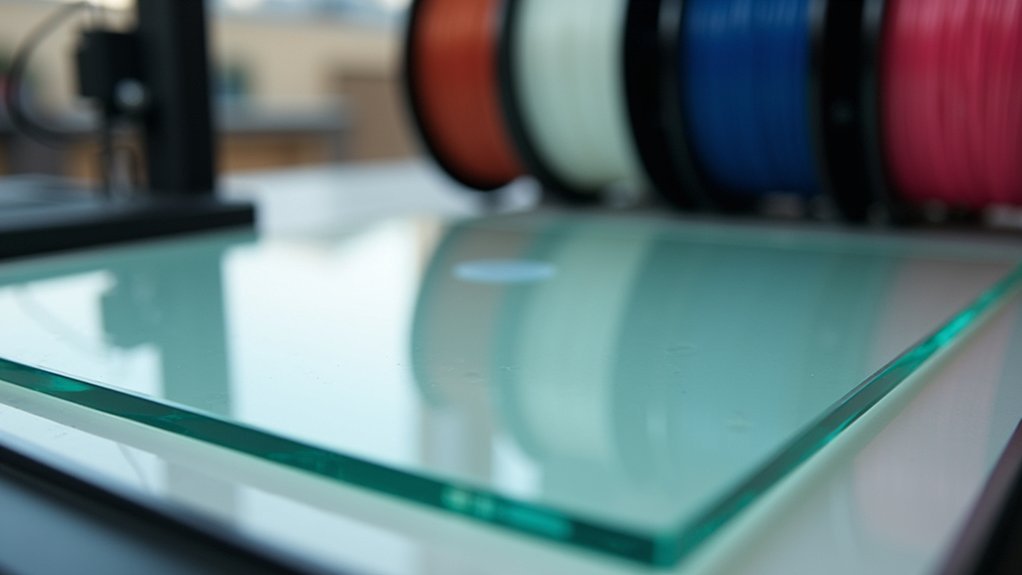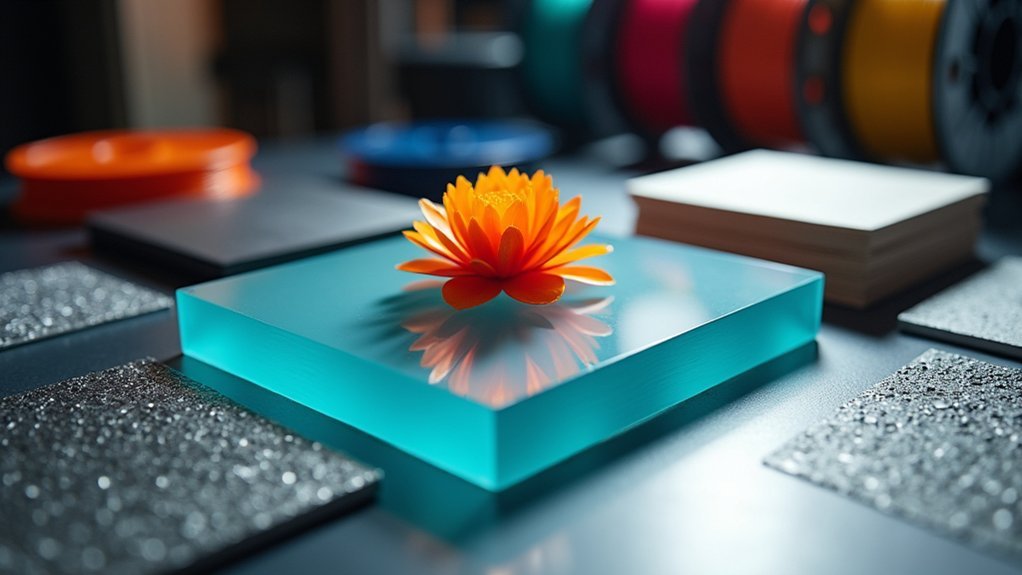You’ll get the best results with a textured PEI build plate for your PLA prints. It provides excellent adhesion without needing glue sticks or other messy adhesives, while releasing prints easily once the bed cools down. The textured surface creates a nice matte finish and works reliably at 60-80°C. Smooth PEI and glass plates are also solid options, though they may require adhesion aids for larger prints. Understanding the nuances of each surface type will help you make the perfect choice.
Why Build Plate Choice Matters for PLA Success

When you’re 3D printing with PLA, your build plate choice can make or break your entire project. A clean surface is essential for successful first-layer adhesion, which directly affects your print quality.
You’ll find that textured PEI surfaces excel for PLA printing because they enhance adhesion without needing additional adhesives. If you prefer a smooth finish, glass or smooth PEI surfaces work well too, though you might need glue or other adhesion promoters.
Maintaining proper bed temperatures between 60 to 80°C improves results and reduces warping.
Don’t forget regular cleaning with warm soapy water or isopropyl alcohol—it’s vital for maintaining your build plate’s effectiveness and ensuring consistent adhesion.
Smooth PEI Plates: The Gold Standard for PLA
Among all build plate options for PLA printing, smooth PEI plates stand out as the gold standard that most experienced makers swear by.
You’ll immediately notice how smooth PEI delivers exceptional adhesion without requiring glue sticks or other adhesive aids. The smooth surface creates a clean, glossy finish on your print’s bottom layer, giving your projects a professional appearance.
You can heat your bed anywhere from 60 to 110°C with confidence, as PEI handles these temperatures without degrading.
Maintenance couldn’t be simpler—just clean with isopropyl alcohol or warm soapy water to maintain ideal adhesion properties.
Users consistently report reliable performance across different printer models, making smooth PEI the trusted choice for consistent PLA printing results.
Textured PEI Surfaces: Enhanced Adhesion Benefits

You’ll find that textured PEI surfaces take adhesion to the next level, gripping your PLA prints more securely than their smooth counterparts.
The textured design isn’t just about holding power—it also creates beneficial surface patterns that enhance your print’s structural integrity and stability during the printing process.
When it’s time to remove your finished print, you’ll appreciate how the texture actually makes release easier once the bed cools down.
Superior PLA Adhesion
Textured PEI surfaces excel at gripping PLA filament through their strategic surface design that creates enhanced contact points between your print and the build plate.
The slight texture increases surface area, allowing your PLA to establish stronger mechanical bonds that prevent warping and lifting during printing. This enhanced grip becomes particularly valuable when you’re printing larger models that experience greater thermal stress.
You’ll achieve superior results by setting your bed temperature between 60-80°C, which activates the PEI surface’s adhesion properties without risking thermal damage.
The textured surfaces also provide an aesthetic bonus—your prints develop an attractive matte finish on the bottom layer.
Regular cleaning with warm soapy water or alcohol maintains peak adhesion performance over time.
Texture Design Benefits
Strategic micro-patterns engineered into PEI surfaces create perfect adhesion through increased surface area that forms stronger mechanical bonds with your PLA filament.
The textured design eliminates warping issues while ensuring your first layer adheres perfectly without additional adhesives or sprays.
You’ll notice dramatically improved bottom finishes with an attractive matte appearance that’s superior to smooth surfaces.
This textured PEI advantage extends beyond aesthetics – it delivers consistent results print after print.
Maintenance remains effortless since you can clean these surfaces with simple warm soapy water or alcohol to restore peak performance.
The versatile design works excellently with multiple filament types including PETG and ABS, making your textured PEI investment worthwhile for various printing projects beyond just PLA applications.
Easy Print Removal
The ideal balance between strong adhesion and effortless removal makes textured PEI surfaces exceptionally user-friendly for PLA printing.
You’ll appreciate how the textured surface grips your print’s bottom layer securely during printing, then releases it easily once cooling begins. Unlike other build plates that require aggressive scraping or soaking, PEI sheets allow prints to pop off with simple flexing of the plate.
This removal mechanism happens because PLA contracts slightly as it cools, reducing its grip on the textured surface. You won’t need tools or excessive force that could damage your prints or the plate itself.
The texture designed into these PEI sheets creates just enough grip to prevent warping while maintaining the easy-release properties that make post-processing quick and stress-free for your printing workflow.
Glass Build Plates: Classic Reliability for PLA Printing

When you’re seeking reliable performance for PLA printing, glass build plates deliver the classic solution that’s proven itself across countless successful prints.
You’ll appreciate how the smooth glass surface guarantees excellent first-layer adhesion while minimizing warping risks that can ruin your projects.
These plates, crafted from borosilicate and tempered glass, resist thermal shock and handle high bed temperatures with ease.
You can clean them effortlessly using isopropyl alcohol, and they’ll accumulate less residue than alternative surfaces, maintaining consistent performance over time.
Popular options like the Creality Borosilicate Glass Bed and Anycubic Ultrabase cost between $20 and $35.
The smooth finish enhances your prints’ aesthetic quality, delivering professional-looking bottom layers that showcase your work’s quality.
Spring Steel Magnetic Systems: Convenience and Performance
You’ll find that spring steel magnetic systems revolutionize your PLA printing experience by combining exceptional convenience with reliable performance.
The flexible plate design lets you easily bend and pop off finished prints without risking damage to your models or the build surface.
This flexibility eliminates the frustrating scraping and prying that’s often required with rigid build plates, making print removal effortless and protecting your valuable creations.
Easy Print Removal
As 3D printing evolves, spring steel magnetic systems have revolutionized how users remove prints from their build plates.
You’ll find that spring steel plates eliminate the frustrating scraping and prying that often damages both your prints and build surface. Instead of wrestling with stubborn parts, you simply flex the plate to pop prints off effortlessly.
The magic happens when your print cools down. The PEI coating provides strong adhesion during printing but releases easily once temperatures drop.
You won’t need putty knives or risk breaking delicate features anymore. This print removal method is particularly valuable for intricate models with fine details or overhangs that would typically snap under traditional removal techniques, making your entire printing workflow more efficient and reliable.
Flexible Plate Benefits
Flexibility transforms your 3D printing experience in ways that extend far beyond simple print removal.
Spring steel magnetic build plates revolutionize how you interact with your printer, offering unmatched convenience and reliability. The PEI coating delivers exceptional adhesion for PLA without requiring additional adhesives, ensuring consistent first layers every time.
Key advantages of flexible plate systems include:
- Effortless plate swapping – detach and reattach plates instantly for continuous printing workflows
- Universal filament compatibility – works seamlessly with various materials beyond just PLA
- Enhanced cleaning accessibility – remove plates completely for thorough maintenance
- Freezer trick capability – place stubborn prints in cold temperatures for easier release
You’ll appreciate how these systems minimize print damage while maximizing productivity, making them essential upgrades for serious makers.
BIQU CryoGrip Pro: Advanced Polymer Coating Technology
When you’re looking for a build plate that eliminates the hassle of adhesion aids, the BIQU CryoGrip Pro delivers with its innovative porous oleophobic polymer coating. This advanced coating provides superior adhesion for PLA without requiring glue sticks or other additions.
Build plates like this one make 3D printing more efficient and reliable. You’ll appreciate how easily prints release by simply flexing the plate after cooling, regardless of your print size.
The polymer coating maintains consistent performance across various temperatures, making it compatible with different filament types beyond PLA. When dealing with stubborn prints, you can place the entire plate in your freezer to assist with removal.
Its universal compatibility with most consumer printers makes it an excellent choice for both hobbyists and professionals.
Tempered Steel Options: Durability and Release Properties
You’ll find tempered steel build plates excel through their spring steel flexibility, which lets you bend the plate to pop prints off effortlessly.
The print release mechanics work by allowing the plate to flex just enough to break the bond between your PLA print and the surface without damaging either.
These plates also distribute heat evenly across their surface, ensuring consistent bed temperatures that promote reliable adhesion during printing and clean release when cooled.
Spring Steel Flexibility
Among the most significant advantages of spring steel build plates is their remarkable flexibility, which transforms print removal from a potentially damaging process into a simple, satisfying motion.
You’ll find that once your PLA print cools down, you can simply bend the spring steel plate to release your finished object without applying excessive force or using removal tools that might damage delicate features.
The flexibility of spring steel creates several practical benefits for your printing workflow:
- Effortless print removal – Gentle bending releases prints without scraping or prying
- Reduced print damage – Eliminates risk of breaking delicate overhangs or thin walls
- Extended plate longevity – No tool scratches on your PEI sheet surface
- Time-saving workflow – Skip adhesive removal and aggressive scraping sessions
Print Release Mechanics
Tempered steel build plates take flexibility benefits even further with specialized engineering that creates superior print release mechanics through thermal contraction dynamics.
You’ll find that these plates use universal coatings that provide strong adhesion during printing while allowing effortless removal once prints cool. The smooth, glass-like finish works exceptionally well with PLA and PETG, ensuring your prints pop off with gentle flexing rather than aggressive scraping.
The tempered steel construction resists warping and maintains consistent performance across multiple printing cycles. You won’t need to worry about damaging your prints or the plate itself during removal.
Many options offer customization features like logos or patterns without compromising the ideal print release mechanics that make these plates increasingly popular among makers.
Heat Distribution Properties
While print release gets much attention, the heat distribution properties of tempered steel plates deserve equal consideration for achieving consistent PLA printing results.
These plates excel at maintaining uniform temperatures across your print surface, eliminating hot spots that cause warping and adhesion issues.
The superior thermal conductivity of tempered steel guarantees your PLA receives consistent heat throughout the printing process. This even heat distribution translates to better first-layer adhesion and reduced print failures.
Key benefits include:
- Excellent thermal conductivity maintains uniform surface temperatures
- Thick 1095 spring steel construction resists warping under heat stress
- Even heat distribution reduces PLA printing failures and inconsistencies
- Superior temperature retention eliminates problematic hot and cold zones
You’ll notice improved print quality and reliability when your build plate delivers consistent thermal performance.
Temperature Requirements: Optimal Heat Settings for PLA
Getting your bed temperature right makes the difference between successful PLA prints and frustrating failures. You’ll need ideal heat settings that balance adhesion with easy print removal from your printing build surface.
| Build Plate Type | Recommended Temperature |
|---|---|
| Glass | 50°C |
| Textured PEI | 60-80°C |
| Standard Smooth | 60°C |
Most PLA filaments work best between 50°C and 70°C, with 60°C being the sweet spot for most situations. Glass surfaces typically require lower temperatures around 50°C, while textured PEI surfaces can handle higher ranges up to 80°C for better adhesion.
Here’s a pro tip: let your bed cool below 50°C after printing. Your PLA parts will release much easier, preventing damage during removal.
Print Removal Techniques: Protecting Your Models and Plate
Proper removal techniques can save both your finished prints and your build plate from unnecessary damage. When you’re protecting your models, patience is your best ally.
Allow prints to cool completely on the build plate, as this naturally reduces adhesion and makes removal considerably easier.
- Cool completely – Wait for prints to reach room temperature before attempting removal
- Flex gently – Use your build plate’s flexibility (like WhamBam PEI) to help release prints naturally
- Use proper tools – Employ thin, flexible spatulas to carefully pry prints without scratching surfaces
- Try freezing – Place stubborn prints in the freezer briefly to contract materials for easier removal
Regular cleaning with isopropyl alcohol maintains ideal adhesion while preventing future removal difficulties.
Cleaning and Maintenance: Keeping Your Build Surface Optimal
Because your build plate’s surface directly impacts every print you make, maintaining its cleanliness becomes crucial for consistent results. Regular cleaning with warm soapy water and a lint-free cloth prevents residue buildup that compromises adhesion. You can also use isopropyl alcohol, though be cautious as it may spread skin oils that affect adhesion.
| Cleaning Method | Best Practice |
|---|---|
| Warm soapy water | Use lint-free cloth regularly |
| Isopropyl alcohol | Apply carefully to avoid spreading oils |
| Surface inspection | Check for warping and wear signs |
| Pre-print preparation | Remove all dust and contaminants |
| Material selection | Avoid abrasive cleaning tools |
Never use abrasive materials that’ll scratch your build surface, as damaged areas lead to print failures. Check periodically for warping or wear signs, and always verify your surface is dust-free before starting prints for ideal adhesion.
Common PLA Adhesion Problems and Solutions
Even with a perfectly clean build surface, you’ll occasionally encounter PLA adhesion challenges that can derail your printing projects. Understanding common problems and their solutions helps guarantee consistent printing success.
Mastering PLA adhesion troubleshooting transforms frustrating print failures into reliable, successful projects every time.
The most frequent adhesion issues stem from preventable causes:
- Warping corners – Maintain bed temperature between 60-70°C to prevent uneven cooling
- Poor first-layer adhesion – Clean your surface with isopropyl alcohol or warm soapy water before each print
- Parts detaching mid-print – Apply glue stick or adhesive promoter, especially on glass plates for larger prints
- Inconsistent adhesion – Switch to textured PEI surfaces for reliable adhesion without additional adhesives
Regular maintenance and proper temperature settings solve most adhesion problems.
Glass plates work well but often need adhesion aids, while textured PEI provides superior natural adhesion.
Comparing Top Build Plate Brands for PLA Performance
When selecting a build plate specifically for PLA printing, several manufacturers have distinguished themselves through consistent performance and innovative surface technologies.
The Tyson Flex Plate System stands out with its universal coating that delivers excellent PLA adhesion while ensuring easy release when cooled, producing smooth bottom finishes on your prints.
BIQU’s CryoGrip Pro Glacier takes a different approach, featuring a porous oleophobic polymer coating that grips PLA effectively without requiring glue or adhesives. This eliminates the mess and preparation time you’d typically encounter with other build surfaces.
Traditional textured PEI plates remain highly recommended, providing strong adhesion without additional adhesives.
Meanwhile, smooth surfaces like glass or PEI offer clean aesthetic finishes with minimal adhesive requirements, making them reliable choices for consistent PLA printing results.
Frequently Asked Questions
What Is the Best Build PLAte for PLA?
You’ll find textured PEI plates work best for PLA since they provide excellent adhesion without extra adhesives. Alternatively, you can choose smooth glass plates or flexible systems like Tyson Flex for easy removal.
What Is the Best Build PLAte Temperature for PLA?
You’ll want to set your build plate temperature between 50°C to 70°C for PLA. Around 60°C works best for most situations, providing excellent first layer adhesion without causing warping or stringing issues.
What Print Bed Surface Is Best for PLA?
You’ll get the best results with a textured PEI plate, which provides excellent adhesion without extra adhesives. Smooth glass plates work well too, offering clean finishes and easy removal after cooling.
Is a Textured Build PLAte Good for PLA?
Yes, you’ll find textured build plates excellent for PLA printing. They’ll enhance adhesion, reduce warping, improve first-layer quality, and make print removal easier once cooled, especially beneficial for larger prints.





Leave a Reply